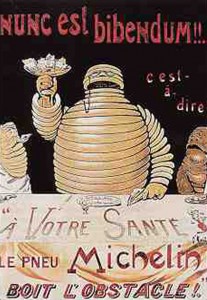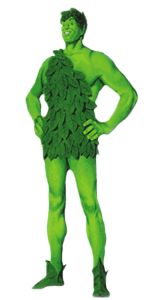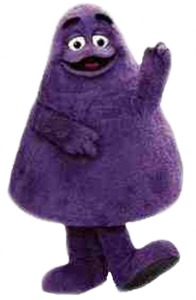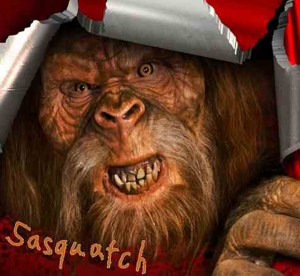MEMORABLE SPOKESMONSTERS THROUGH THE AD AGES
Published in Reel Chicago, October 2014
![]()
Barkers bark and pitch men pitch, but sometimes it’s the monster who sells.
For more than a century, g hosts, giants and beasts representing brands have met or exceeded their sales quotas on everything from tires to sausages.
hosts, giants and beasts representing brands have met or exceeded their sales quotas on everything from tires to sausages.
As a Halloween treat, we present five of the most lucrative supernatural creatures in the history of advertising.
Spokesmonsters, if you will.
And you will.
![]()
Bibendum, aka “The Michelin Man,” (1898, Michelin Tires)
 The Michelin Man, born with a drink in his hand, is arguably the world’s first spokesmonster.
The Michelin Man, born with a drink in his hand, is arguably the world’s first spokesmonster.
He began his career in the late 1800’s as a giant, beer loving, not-quite-human thing in a poster that French artist Marius Rossillon (aka “O’Galop) pitched to a brewery in Munich. The words “Nunc est bibendum” appeared beneath him. Translated from Latin, they declare, “Now is the time to drink.”
The brewery turned down the idea. O’Galop persisted.
In 1898, he showed the poster to Edouard and André Michelin, brothers who owned a rubber factory and sold bicycle tires on the side. It reminded Edouard of a stack of tires he had seen at the Universal and Colonial Exposition in Lyon four years earlier. The Michelins persuaded O’Galop to change the thing’s torso to look as if it was made out of tires, but they told him to leave the toast untouched. “Bibendum” had arrived.
In the first ad featuring his image, Bibendum offers a cocktail full of road hazards to several of his competitors. A French inscription on his glass suggests that the words, “we drink,” mean that Michelin tires can swallow any obstacle in their path.
Since then, Bibendum has cleaned up, lost weight and, for a short time after the addition of carbon into rubber turned the color of tires from white to black, was black. He also switched his handle to “Michelin Man.”
In 1999, Advertising Age listed the Michelin Man eighth among the top advertising icons of the 20th century.
![]()
The Jolly Green Giant (1928, Minnesota Valley Canning Co.)
 The handsome, leaf-clad corn pusher we call “The Jolly Green Giant” actually refers to the name given to a variety of supersized peas, the “Prince of Wales,” that the Minnesota Valley Canning Company tried to sell to brands in the early 1920’s.
The handsome, leaf-clad corn pusher we call “The Jolly Green Giant” actually refers to the name given to a variety of supersized peas, the “Prince of Wales,” that the Minnesota Valley Canning Company tried to sell to brands in the early 1920’s.
Finding no takers, the company decided to do the branding itself, debuting “Green Giant Great Big Tender Peas” in 1925.
The first version of the mascot appeared three years later. He was modeled after the hero of a Brothers Grimm fairytale, “Der Bärenhäuter” (“Bearskin”). Like the main character in this Faustian childrens tale, the original Green Giant wore a bearskin cloak that made him appear savagely primordial.
In 1935, copywriter Leo Burnett gave the Green Giant a makeover, transforming him into the clean shaven, subtly flamboyant titan we know today.
Since then, the Jolly Green Giant’s celebrity has grown larger than life. Along Minnesota Route 169, an hour’s drive from a section of the state designated as “The Valley of the Green Giant” by an enormous billboard, there is a 55-foot statue of the spokesmonster. Songs in his honor performed by The Kingsmen and Tenessee Ernie Ford celebrate his love life and his vocal prowess.
In 1999, Advertising Age ranked the Jolly Green Giant third among the top advertising icons of the 20th century.
![]()
Count Chocula, Franken Berry and Booberry (1971-73, General Mills)
Vampires, corpses and ghosts have never been as harmless as Count Chocula, Franken Berry and Booberry.
 Introduced in the early 1970’s to represent the first cereals with chocolate, strawberry and blueberry-flavored marshmallows in their ingredients, the trio of spokesmonsters for General Mills’ “Monster Cereals” wield all the danger of a talking puppy as they charm kids into consuming bowl after bowl of whispy sweet modified grains.
Introduced in the early 1970’s to represent the first cereals with chocolate, strawberry and blueberry-flavored marshmallows in their ingredients, the trio of spokesmonsters for General Mills’ “Monster Cereals” wield all the danger of a talking puppy as they charm kids into consuming bowl after bowl of whispy sweet modified grains.
Two additional cereals, Yummy Mummy and Fruit Brute, belonged to the same category for a while (though Yummy Mummy was not officially part of the Monster Cereal group,) but both brands were discontinued in the 1980’s.
This past August, General Mills updated its “Monster Cereals” in high style. The Minnesota-based food company partnered with DC Entertainment and hired legendary DC Comic artist Jim Lee — whose resume includes work on Bat Man, Superman and the Justice League — to illustrate the new Boo Berry.
According to a statement posted by General Mills social engagement specialist Lynne Morioka, the artist was thrilled.
“To me he was not just a Monster,” says Lee, who names Boo Berry as his favorite cereal growing up. “He was the smartest of the trio.”
![]()
Grimace (1971, McDonald’s)
Hard to believe, but this goofy purple blob was originally designed to steal milkshakes from the mouths of unsuspecting kids.
 Introduced in 1971 by Leo Burnett, “Evil Grimace” sported a furry coat and two pairs of arms, presumably to enhance his thieving abilities. Over the next three years, he began transforming into the adorable halfwit we all know and love, shedding the word “Evil” from his name and dropping a pair of limbs from his torso.
Introduced in 1971 by Leo Burnett, “Evil Grimace” sported a furry coat and two pairs of arms, presumably to enhance his thieving abilities. Over the next three years, he began transforming into the adorable halfwit we all know and love, shedding the word “Evil” from his name and dropping a pair of limbs from his torso.
In 1999, consumers got to know some of Grimace’s family through the animated feature, “Grimace Island.” Among the relatives featured in the film is Uncle O’Grimacey, who only comes around during St Patrick’s day.
To date, Grimace has not been charged with any crime resulting from the alleged larceny that inspired his early career. This may be because Mayor McCheese and Officer Big Mac have got bigger meat to fry, as the latest fake reports invented by Reel Chicago confirm that the Hamburglar is still at large.
Grimace is often recognized as Ronald McDonald’s most loyal friend.
![]()
Sasquatch (2012, Jack Link’s)
Sasquatch is real and, evidently, dislikes practical jokes as much as your grouchiest uncle.
 Although it seems obvious that disturbing him pretty much always causes injury — as the commercials for Jack Link’s meat snacks created by agency Carmicahel Lynch have shown time and time again — the stoner buffoons who happen upon the beast can’t get enough of his reactionary, bone crushing violence.
Although it seems obvious that disturbing him pretty much always causes injury — as the commercials for Jack Link’s meat snacks created by agency Carmicahel Lynch have shown time and time again — the stoner buffoons who happen upon the beast can’t get enough of his reactionary, bone crushing violence.
Their stupidity has paid off. Since launching less than a decade ago, “Messin’ with Sasquatch” has evolved into “Snackin’ with Sasquatch,” a campaign that features the spokesmonster playing cards and enjoying classical music, although he still has a quick and often violent temper.
During the same time, the Jack Link’s brand has risen to become the top-selling convenience store snack.